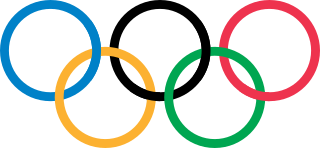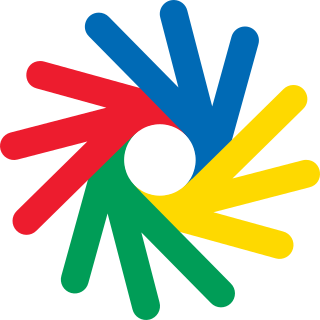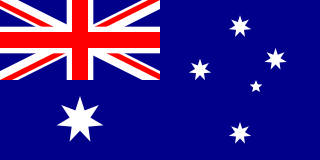Related Research Articles

The modern Olympic Games or Olympics are leading international sporting events featuring summer and winter sports competitions in which thousands of athletes from around the world participate in a variety of competitions. The Olympic Games are considered the world's foremost sports competition with more than 200 nations participating. The Olympic Games are normally held every four years, alternating between the Summer and Winter Games every two years in the four-year period.

The Paralympic Games or Paralympics are a periodic series of international multi-sport events involving athletes with a range of disabilities, including impaired muscle power, impaired passive range of movement, limb deficiency, leg length difference, short stature, hypertonia, ataxia, athetosis, vision impairment and intellectual impairment. There are Winter and Summer Paralympic Games, which since the 1988 Summer Olympics in Seoul, South Korea, are held almost immediately following the respective Olympic Games. All Paralympic Games are governed by the International Paralympic Committee (IPC).

The International Paralympic Committee is an international non-profit organisation and the global governing body for the Paralympic Movement. The IPC organizes the Paralympic Games and functions as the international federation for nine sports. Founded on 22 September 1989 in Düsseldorf, Germany, its mission is to "enable Paralympic athletes to achieve sporting excellence and inspire and excite the world". Furthermore, the IPC wants to promote the Paralympic values and to create sport opportunities for all persons with a disability, from beginner to elite level.

The 1988 Summer Paralympics, were the first Paralympics in 24 years to take place in the same city as the Olympic Games. They took place in Seoul, South Korea. This was the first time the term "Paralympic" came into official use.

The 2010 Winter Paralympics, officially the X Paralympic Winter Games, or the tenth Winter Paralympics, were held in Vancouver and Whistler, Canada from March 12 to 21, 2010. The Opening Ceremony took place in BC Place Stadium in Vancouver and the Closing Ceremony in Whistler. With a theme of "One Inspires Many," the Opening Ceremony featured over 5000 local performers. Fifteen-year-old snowboarder Zach Beaumont, who is an amputee, was the final torch bearer and lit the Games Cauldron. The 2 hours live ceremony was produced by Vancouver-based Patrick Roberge Productions Inc.

The United States Olympic & Paralympic Committee (USOPC) is the National Olympic Committee and the National Paralympic Committee for the United States. It was founded in 1895 as the United States Olympic Committee, and is headquartered in Colorado Springs, Colorado. The USOPC is one of only four NOCs in the world that also serve as the National Paralympic Committee for their country. The USOPC is responsible for supporting, entering and overseeing U.S. teams for the Olympic Games, Paralympic Games, Youth Olympic Games, Pan American Games, and Parapan American Games and serves as the steward of the Olympic and Paralympic Movements in the United States. The US will next compete in the 2020 Summer Olympics.

The 1976 Summer Paralympics, branded as Torontolympiad – 1976 Olympiad for the Physically Disabled, was the fifth Paralympic Games to be held. They were hosted by Toronto, Canada, from 4 to 12 August 1976, marking the first time a Paralympics was held in Americas and in Canada. The games began three days after the close of the 1976 Summer Olympics in Montreal.

The 1980 Summer Paralympics, branded as the Olympics for the Disabled, were the sixth Summer Paralympic Games. They were held in Arnhem, Netherlands, from 21 to 30 June 1980.

The 1984 International Games for the Disabled, canonically the 1984 Summer Paralympics were the seventh Paralympic Games to be held. There were in two separate competitions: one in Stoke Mandeville, United Kingdom for wheelchair athletes with spinal cord injuries and the other at the Mitchel Athletic Complex and Hofstra University in Long Island, New York, United States of America for wheelchair and ambulatory athletes with cerebral palsy, amputees, and les autres [the others]. Stoke Mandeville had been the location of the Stoke Mandeville Games from 1948 onwards, seen as the precursors to the Paralympic Games. As with the 1984 Summer Olympics, the Soviet Union and other communist countries except China, East Germany, Hungary, Poland and Yugoslavia boycotted the Paralympic Games. The Soviet Union did not participate in the Paralympics at the time, arguing that they have no disabled people in the country. The USSR made its Paralympic debut in 1988, during Perestroika.

The Deaflympics are an International Olympic Committee (IOC)-sanctioned event at which deaf athletes compete at an elite level. Unlike the athletes in other IOC-sanctioned events, the Deaflympians cannot be guided by sounds. The games have been organized by the Comité International des Sports des Sourds since the first event in 1924.

National Olympic Committees that wish to host an Olympic Games select cities within their territories to put forth Bids for the Olympic Games. The staging of the Paralympic Games is automatically included in the bid. Since the creation of the International Olympic Committee (IOC) in 1894, which successfully appropriated the name of the Ancient Greek Olympics to create a modern sporting event, interested cities have rivaled for selection as host of the Summer or Winter Olympic Games.

The Paralympic sports comprise all the sports contested in the Summer and Winter Paralympic Games. As of 2016, the Summer Paralympics included 22 sports and 526 medal events, and the Winter Paralympics include 5 sports and disciplines and about 72 events. The number and kinds of events may change from one Paralympic Games to another.

The Paralympic symbols are the icons, flags, and symbols used by the International Paralympic Committee to promote the Paralympic Games.

The National Olympic Committee of Ukraine is a non-profit all-Ukrainian public organization responsible for development, reinforcement, and protection of the Olympic movement. The committee has an exclusive right to represent Ukraine in the Olympic Games and other competitions of the International Olympic Committee.

The Summer Paralympic Games or the Games of the Paralympiad, are an international multi-sport event where athletes with physical disabilities compete. This includes athletes with mobility disabilities, amputations, blindness, and cerebral palsy. The Paralympic Games are held every four years, organized by the International Paralympic Committee. Medals are awarded in each event, with gold medals for first place, silver for second and bronze for third, a tradition that the Olympic Games started in 1904.

Australia has participated officially in every Summer Paralympics Games since its inauguration in 1960 and in the Winter Paralympics Games since 1980.
Paralympics Australia (PA) previously called Australian Paralympic Committee (APC)(1998-2019) is the National Paralympic Committee in Australia for the Paralympic Games movement. It oversees the preparation and management of Australian teams that participate at the Summer Paralympics and the Winter Paralympics.

At the 2010 Winter Paralympics in Vancouver, British Columbia, Canada Australia sent ever of 11 competitors to compete against 42 other nations with a total of 502 competitors making these Paralympics the largest ever with only 39 countries competing at Torino in 2006. Of these other nations, 2010 was the first winter paralympics for Argentina, Bosnia & Herzegovina, Romania, Russian Federation, and Serbia. The delegation also consisted of 3 sighted guides and 17 support staff. This was the largest delegation Australia had sent to a Winter Paralympics. Australia has participated in every winter Paralympics. In 2010, Dominic Monypenny became the fourth Australian athlete to participate in both the Summer and Winter Paralympic Games, the others being Kyrra Grunnsund, Anthony Bonaccurso, and Michael Milton. In the lead-up to the 2010 winter Games, nine of the 11 Australian athletes had recorded top 10 finishes in Paralympic, world cup or world championship competition in their class.

The 1984 Winter Paralympics, then known as The Third World Winter Games for the Disabled, were held in Innsbruck, Austria. The games took place from the 15 until 21 January. Present at these games were 419 athletes from 21 countries, Spain and the Netherlands competing for the first time in the Winter Paralympics, competing in 107 events across 3 sports. The inclusion of Les Austres and Cerebral palsy impairment groups contributing to the distinct increase in athlete participation with the total number of athletes jumping from 229 at Geilo, Norway in 1980.

Following the success of the first ever 1976 Winter Paralympics in Örnsköldsvik four years earlier, Norway was selected to host the Paralympic Games in 1980.
References
- 1 2 3 4 5 6 7 8 9 10 11 12 13 14 Vanlandewijck, Yves (2011). The Paralympic Athlete : Handbook of Sports Medicine and Science . Chichester, West Sussex: Wiley-Blackwell. pp. 3–30.
- 1 2 3 4 5 6 7 8 9 10 11 12 DePauw, Karen; et al. (2005). Disability sport (2nd ed.). Champaign, Ill.: Human Kinetics. pp. 277–287.
- 1 2 3 "Paralympics - History of the movement". International Paralympic Committee website. Retrieved 4 March 2015.
- 1 2 3 4 5 6 7 8 9 10 11 12 13 14 15 16 17 18 19 20 21 22 23 24 25 26 "Summer Games Overview". International Paralympic Committee website. Retrieved 10 March 2015.
- 1 2 3 4 5 6 7 8 9 10 Ottoblock. "History of the Paralympic Games" (PDF). Channel 4 website. Retrieved 10 March 2015.
- 1 2 3 4 5 6 7 8 9 10 11 12 13 14 15 16 17 18 19 20 21 22 "Winter Games Overview". International Paralympic Committee website. Retrieved 10 March 2015.
- 1 2 3 "The History of the Paralympic Movement". Inside the Games website. Retrieved 4 March 2015.
- ↑ "About Us". International Paralympic Committee website. Retrieved 4 March 2015.
- 1 2 3 4 5 6 7 8 9 10 11 12 13 14 15 16 17 18 19 20 21 "25-year anniversary of the IPC". International Paralympic Committee website. Retrieved 10 March 2015.